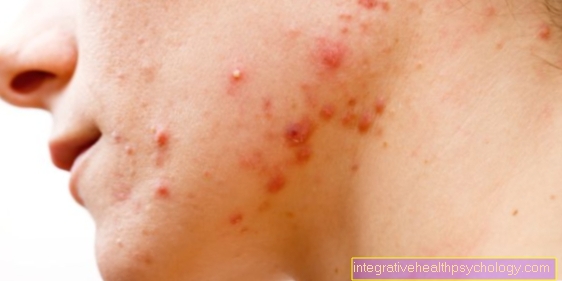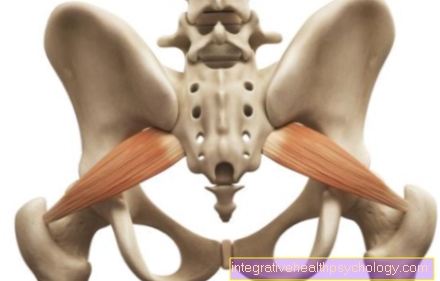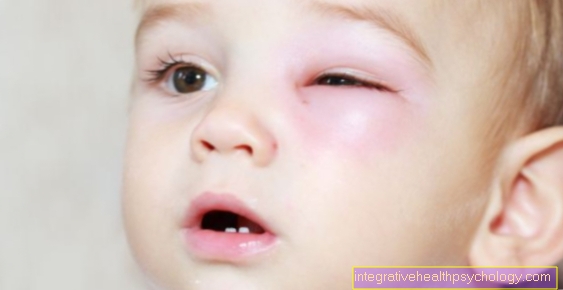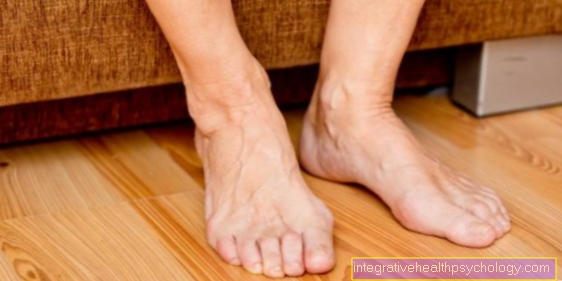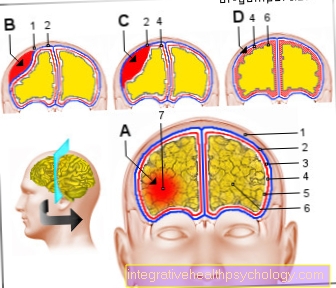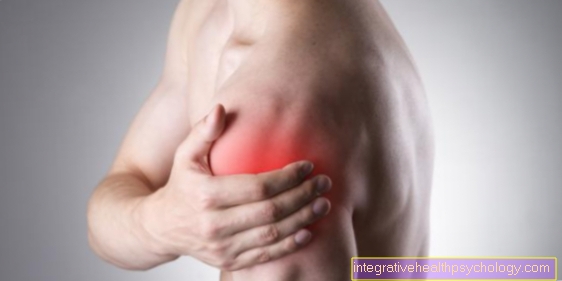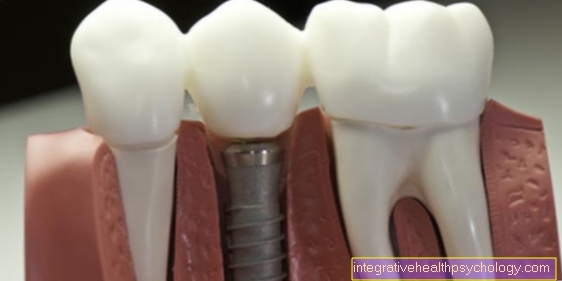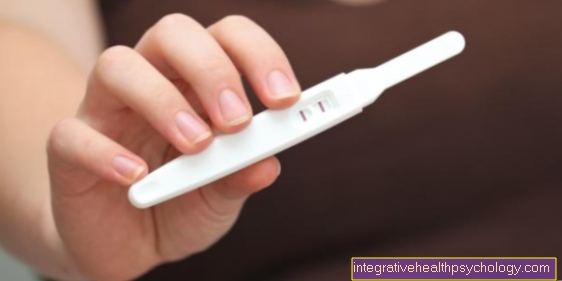Bouchard osteoarthritis
What is Bouchard osteoarthritis
Bouchard's osteoarthritis is a degenerative disease of the anterior finger joints, also known as proximal interphalangeal joints (PIP). It usually occurs as a result of long-term wear and tear on the joints due to incorrect loading and is therefore more common, especially in older people. Osteoarthritis is a non-inflammatory change in the articular cartilage caused by wear and tear, which over time becomes noticeable in pain and restricted mobility. Heberden's arthrosis, which affects the posterior finger joints, must be distinguished from it.

Treatment / therapy
In the treatment of Bouchard's osteoarthritis, the focus is on preventing the disease from progressing and treating the pain acute. Complete freedom from pain and movement should be achieved. An important part of the treatment is active exercise therapy. This can be done by the patient himself or together with a physiotherapist. In addition, strengthening exercises for the finger muscles are recommended, for example with the help of a softball. Exercising in the water can also be helpful.
In the case of an acute flare-up of osteoarthritis, the use of pain reliever and anti-inflammatory drugs (NSAIDs), such as ibuprofen or diclofenac, can help. If the pain continues to be severe, some doctors use injection therapies into the finger joints, for example using hyaluronic acid. This is a naturally occurring substance in the synovial fluid.
If no improvement can be achieved after intensive conservative therapy, surgical treatment can help in rare cases.
Read more on this topic at:
- Treatment of finger osteoarthritis
- Home remedies for finger osteoarthritis
- Hyaluronic acid
homeopathy
Homeopathy for Bouchard osteoarthritis can help alleviate the symptoms. When choosing the right remedy, you should contact an expert beforehand, as it depends on the degree of osteoarthritis and other diseases. A selection of homeopathic remedies is for example: Rhus toxicodendron, Caulophyllum, Devil's Claw or Causticum.
Read more on this topic at: Homeopathy for osteoarthritis
surgery
In rare cases, surgical treatment can be helpful to prevent the disease from progressing. One method could, for example, be the removal of destroyed cartilage from the finger joint, for example in the form of a synovectomy or denervation. One also speaks of one Radiosynoviorthesis.
If the symptoms persist anyway, a joint stiffening can be carried out, a so-called Arthrodesis. The finger joint is stiffened using plates or screws so that it can no longer be moved. This has the advantage of total pain relief, but the finger can no longer be bent in this joint.
It is important to mention that surgical treatment can by no means achieve a cure for the disease, at best it can alleviate the symptoms and prevent its progression.
Read more on this topic at:
- Finger osteoarthritis surgery
- Surgery for osteoarthritis
Can diet affect Bouchard osteoarthritis?
Good nutrition is very important, if not the most important factor in preventing osteoarthritis. Since osteoarthritis often occurs in overweight people, for whom the high weight leads to incorrect stress in the joints, weight reduction is very important.
But even with existing osteoarthritis, the right diet can help prevent progression and reduce pain. Means that have a positive effect on the bone and cartilage substance are particularly important. These are mainly vitamins and minerals. Recommended foods are peppers, kiwi, lemon, fruits, and vegetable oils.
It is also important to avoid foods that damage the joints and cartilage. These are, for example, meat, eggs, cheese, butter. However, everything should not be missed out; what is important is a balanced nutrition plan, which is best drawn up with the help of a nutritionist.
Read more on this topic at: Diet for osteoarthritis
Course of Bouchard's osteoarthritis
Bouchard osteoarthritis takes place in different phases. The symptoms often begin with slight pain, which increases with movement and during the day. Movement restrictions and deformations of the fingers occur later. Large lumps often appear on the joints in higher stages.
X-rays generally distinguish between 4 stages. In the initial stage you don't have to see any symptoms, but the x-ray shows changes in the joint space and effusions. It is often an incidental finding. In the second stage, the joint space becomes narrower as the cartilage continues to break down. In addition, cysts can appear. If the cartilage in the joint is completely destroyed, then stage 4 has been reached.
Read more on this topic at:
- Arthrosis stages
- Course of osteoarthritis
causes
Bouchard osteoarthritis mainly occurs as a result of wear and tear due to long-term incorrect and excessive strain. It is a common condition, especially in the elderly. It is rare in young people, but a genetic component is discussed. Arthrosis in the finger joints can also occur as a result of previous injuries, such as healed bone fractures, inflammation in the area of the joints (synovitis) or osteoarthritis in other joints.
Often, osteoarthritis does not only occur in one joint; the majority of patients suffer from degenerative signs of wear and tear in several joints, including the foot or hip. If there are five or more affected joints, one speaks of polyarthrosis. In women, the hormonal change after menopause also plays an important role, which is why women are more often affected.
Read more on this topic at:
- Causes of finger osteoarthritis
- Cause of osteoarthritis
Why is this so common with Heberden's osteoarthritis?
Similar to Bouchard's arthrosis, Heberden's osteoarthritis is a degenerative wear disease of the finger joints, but it affects the posterior joints (distal interphalangeal joints, DIP). Why these two types of osteoarthritis often occur together is not clinically clear. However, it is believed that the simultaneous movement of the posterior and anterior finger joints both stress and wear to the same extent. Moving the posterior finger joints alone is relatively rare.
Read more on this topic at:
- Finger osteoarthritis
- Heberden osteoarthritis
How can you distinguish Heberden's osteoarthritis from rheumatism?
In contrast to osteoarthritis, rheumatism affects not only the joint, but also the surrounding tissue. One also speaks of rheumatoid arthritis. This is often characterized by severe inflammation, which means that there are more inflammation-specific symptoms such as warmth, redness and swelling, which are less common with osteoarthritis. Often not only the joints are affected, but also the tendons, ligaments and joint capsules. A good distinction between rheumatism or osteoarthritis can be made with the help of the localization of the symptoms. While Bouchard's arthritis only affects the anterior and Heberden's arthrosis the posterior finger joints, rheumatoid arthritis primarily affects the joints of the wrist and the metatarsophalangeal joints.
Read more on this topic at:
- Rheumatoid arthritis
- rheumatism
You can recognize Bouchard osteoarthritis by these symptoms
The typical symptom of Bouchard osteoarthritis is pain in the affected finger. This pain mainly occurs when the patient tries to grip something difficult with their fingers or want to open a bottle. Palpable nodules, so-called nodules, are often signs of osteoarthritis Osteophytes, on the finger joints and misalignment of the fingers occurs over time.
The degeneration leads to a loss of strength and restricted mobility, for example in the form of a reduced ability to bend. There is a certain stiffness in the fingers. Some patients also report swelling of the finger joints, which is usually due to swelling of the joint capsule.
Read more on this topic at: Symptoms of osteoarthritis
Pain
The characteristic pain for finger joint arthrosis is load-dependent pain. This means that they mainly occur when turning movements. Chronic osteoarthritis, in which the cartilage has already completely broken down, can also lead to pain at rest. As a rule, the pain gets worse during the day and is only relieved by rest or heat treatment. One also speaks of fatigue pain.
Osteoarthritis attack
Typical of osteoarthritis, regardless of the affected joint, is the occurrence of pain in attacks. In some cases, acute pain can be accompanied by pain-free intervals lasting for months. An osteoarthritis attack is usually characterized by morning stiffness and a start-up pain. Redness and joint effusion can also occur during the episode. Often this is also accompanied by joint swelling and a complete loss of function. In severe cases, osteoarthritis can also lead to inflammation in the finger joints, although this must be differentiated from rheumatoid arthritis.
Read more on this topic at: Osteoarthritis attack
diagnosis
The diagnosis begins with a detailed medical history and physical examination. During the examination, the doctor examines the joints for possible swelling and redness and checks them for movement restrictions. To do this, he moves all the fingers and performs special functional tests. He will also check the other joints of the fingers. When taking the anamnesis, questions are asked about accidents in the past or similar complaints with relatives.
To confirm the diagnosis of osteoarthritis, the doctor must resort to the use of an X-ray examination. There are specific changes in the X-ray that indicate osteoarthritis, including narrowing the joint space and cyst formation. In addition, specific parameters in the blood can be tested. When diagnosing it, it is important to rule out other diseases or causes for the symptoms, such as rheumatoid arthritis or Heberden's osteoarthritis.
Read more on this topic at: Diagnosis of osteoarthritis




